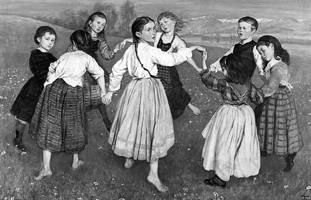
|
The Society of Folk Dance Historians (SFDH)
Recreation in Folk Dancing
[
Home |
About |
Encyclopedia | CLICK AN IMAGE TO ENLARGE |

|
 I took an abnormal psych course, once. In some institutions, the difference between the patients and the doctors is that the doctors have the KEYS.
I took an abnormal psych course, once. In some institutions, the difference between the patients and the doctors is that the doctors have the KEYS.
Same with folk dancing. No, we're not crazy! But dancers are to leaders as mental patients are to doctors. In other words, there is no essential difference between recreational folk dancers and their leaders. Let me explain.
Psychotherapy involves change for both the therapist and the patient. Both evolve, or neither will evolve. Same with folk dance recreation leadership. Both leader and student must learn to "lead" in order to recreate.
But most dancers want only to "Shut up and dance!" They want ACTION. Well, the great recreation leaders, for example, Jane Farwell or Glenn Bannerman, knew this and never presented "recreation" as a subject so much as they made us act out "how to present recreation."
Three times I saw Jane present "how to organize and conduct parties." You know the drill. Pick a theme, put everyone on committees, build anticipation all day, and memorialize it for later (Jane Farwell. undated. Folk Dances for Fun). So people enjoy the event three times: in the build-up, at the party, and remembering it. Jane's camps, Oglebay, Maine, and Texas, didn't transmit countless dances, but the parties were legendary! People had fun, built community, and came to appreciate ethnic crafts, costumes, meals, skits, language, music, and song.
Two times I saw Glenn present recreation: he focused more on games and entertainment, for example, making a rabbit or mouse or finger puppet out of a handkerchief. (Glenn Bannerman & Robert Fakkema. 1975. Guide for Recreation Leaders) But the point is that Glenn (and Jane) didn't give us recreation. Instead, they TAUGHT US TO GIVE RECREATION TO OTHERS. They treated us dancers as if we were leaders.
So let's try to present to others the PRESENTATION of recreation through two vehicles: folk dance and song. I'm still working out these programs, so be patient and offer your suggestions.
RECREATION: Teaching Others to Dance
What makes a dance recreational?
- It creates CONFLICT. SAY WHAT? Dean John Silber (before he was fired) reported a valuable lesson learned from his nemesis, former UT Regent Frank Erwin (Alcade, July/August 2007): "Where there is no conflict, there is no interest." You want to interest people? Teach a dance that has conflict. It can be a musical or political or kinesthetic conflict. The best ones involve sexual conflict--men dancing with women. Quoting Dick Crum (EEFC Archives, August 20, 2003):
"I taught an extension course in Balkan Folk Dance at Duquesne University in Pittsburgh. First session, about 20 students, all folk dancers, most in their late teens or early 20s. Poised with a flipchart and marker, I threw out my opener: "Let's list the various reasons why we folk dance." . . . The third respondent, a tanktopped Californian surfer type named Chip, shouted, "I go folk dancing to SCORE! Doesn't everybody?" . . . not one of the participants challenged Chip's point."
Line dancing is fine, but for REAL conflict, teach couple dances.
- It involves "SUBSTANCE." I quote again: (Michael Herman's Sessions at the Balkan Festival; Los Angeles, California. February, 1963):
"The average teacher in looking for real easy Kolos to use with real beginners might pick on Neda Grivne, because it truly is so easy. Oddly enough it is NOT the best kolo to give to beginners. It hasn't enough substance for beginners to understand or appreciate it."
So don't just pick the easiest dance; pick an easy one with substance. And what is substance? I can't tell you – you have to feel it. When you think of a dance, and it makes you pause –––, that dance has substance. Could be great music, could be interesting steps, could be the history behind it. But it makes you pause –––.
- It evokes EMOTION. Music affects me, just as it affects many people. Some of these dances evoke all the heartbreak and joys of our decades in folk dancing – friends found, and friends lost. Others evoke the emotions of the people who created them: the courage of the Scots, the pathos of the Balkans, 'hearth and home' of the English, the pioneer spirit of early Israel, the poetry of the Catalans. These dances evoke emotion, and there is no reason not to pass along that emotion to others.
- It FEELS GOOD. Some dances simply feel good.
So pick dances with conflict, substance, emotion, and "feel good." And just in case it needs saying, recall the advice that Frank Sinatra gave to his favorite singer, Tony Bennett: "Stay away from bad songs, just do great songs." (ABC interview, August 2, 2006). There's a world of wisdom in those words.
And how to teach? Best advice I ever heard is: "Shut up and dance." People follow motion, not words. Rickey Holden, who spread folk dancing around the world, learned in every major language the numbers 1-10, "forward," "back," "side," and "you're wonderful." And he used those words ONLY to keep rhythm, not to direct.
RECREATION: Teaching others to lead and sing-alongs
Early folk dancing included sing-alongs: Oglebay, Stockton, Maine, Texas, and anywhere Jane Farwell went. In Austin, our weekly 'after-parties' included sing-alongs, and I don't believe that we were the only ones.
So what makes a song recreational?
It contains conflict, substance, emotion, and "feel good." Yep, same as folk dance.
Why would you sing "Row, row, row your boat" when you could sing the beautiful "Oh how lovely is the evening" or "Hey, ho, nobody home?"
Why would you sing the one-dimensional "Bingo" when you could sing the socio-politically weighted "Drill ye tarriers" or "Men of Harlech?"
Why would you sing "Found a peanut" when you could have the resonant "Dark as a dungeon" in your throat?"
You can't play guitar? Me neither! But I can fake it, and here's how.
- Learn 4 major scale chords. I started with A, then D, then E, then G:

Note: REAL guitar players do not use these fingerings, so you have a choice: Take years and learn the real fingerings, or take days and be able to accompany any song that you can sing.
- Practice playing either the first 3 chords or the last 3 chords in this order to accompany a major scale.
For a song in D: D, A, D, G, D (or A), G, A, D (and back down.)
For a song in A: A, E, A, D, A (or E), D, E, A (and back down.)
Now, when I say "accompany a major scale," I mean you should finger the chord with your left hand and rake the edge of your right thumb down over the solid-line strings, finger the next chord and rake your thumb down again, etc.

- Add a few minor chords, and you can play ALL the songs on our song sheet.
Learn to strum these chords for the Am scale:
Am, E, Am, D, Am, Dm (fake), G (or E), Am (and back down.)
Or, for a darker tone, switch in a few more minor chords:
Am, Em, Am, D, Am (or Em), Dm (fake), Em, Am (and back down.)
- So, now you've learned the D, A, and Am scales, up and down. Pick a song.
DEEP IN THE HEART OF TEXAS, in D, is a good one to start with. Sing the song and strum the chords where marked. (You can tap the guitar 4 times at the X's.)
The stars at night are big and bright XXXX deep in the heart of Texas.
D
D
D
D
D
D
D
D
D
D
A
A
The prairie sky is wide and high XXXX deep in the heart of Texas.
A
A
A
A
A
A
A
A
A
A
A
D
D
Every note in the song corresponds to a chord on the scale, but you will accompany only the important notes, such as the first note of every bar. Start simple and add chords as you feel comfortable.
Some songs, such as marches, need a full, quick strum across all strings. Others need a slow strum across the bottom 3 or 4 strings, sounding more like a harp. Vary your style and use your judgment.
- Dancing is more than footwork, and leading songs is more than chords. The trick is to get as many people singing as possible.
- Strumming guitar requires calluses even more than it requires practice. So never skip more than one day without playing (and singing) a couple of songs. I try to play three: one in D, one in A, and one in Am, to remind my fingers where the chords are. Let me know how it works out for you.
- Ron Houston, an article.
A. Let the crowd request the songs. The person who requests the song probably knows it and can sing it.
B. Sing rounds, so that everyone participates.
C. Sing "lining" songs, where you sing a line and everyone repeats, for example, "I'm going to leave . . . old Texas now . . . ."
D. Ask selected people to sing selected verses while everyone sings the chorus.
E. Sing verses while everyone sings the chorus.
In other words, let THEM do the singing. You strum, to keep them on key.
I wish you all kinds of luck with this. You may even revive folk dancing through an emphasis on recreation.
DOCUMENT
Used with permission of the author.
This page © 2018 by Ron Houston.
Please do not copy any part of this page without including this copyright notice.
Please do not copy small portions out of context.
Please do not copy large portions without permission from Ron Houston.